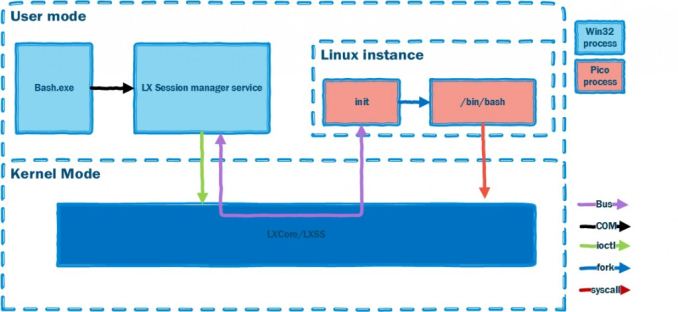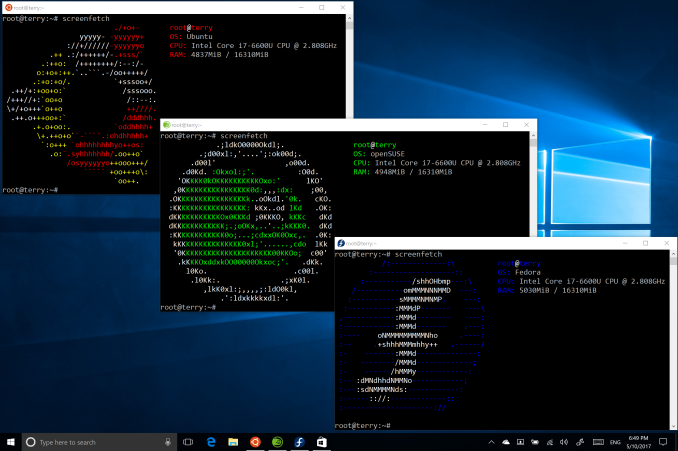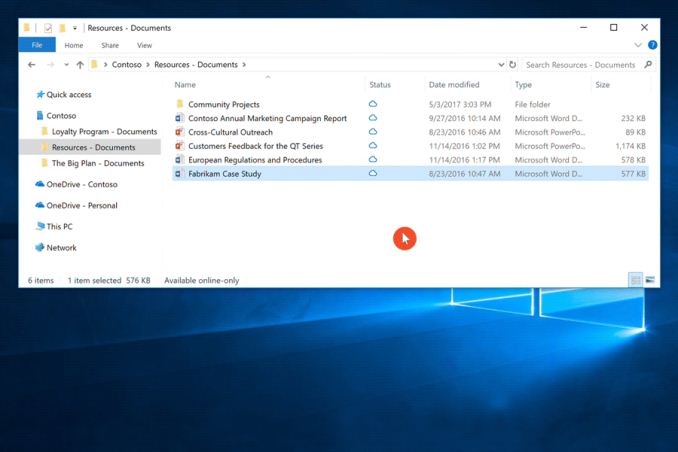The Microsoft Build 2017 Recap: What To Expect When You’re Expecting Windows
by Brett Howse on May 19, 2017 8:00 AM ESTWindows Subsystem for Linux
Microsoft bringing Linux into the Windows platform was one of the most surprising announcements at Build last year, and as we discussed in the Creators Update, they’ve continued to improve their Windows Subsystem for Linux (WSL) with quite a few new features coming earlier this year. Considering Build is a developer conference, and the Linux capabilities are being added to address their needs, it shouldn’t be a huge surprise that more features are coming, but the announcements were surprising nonetheless.
With the shipping version of Windows, enabling the Linux subsystem does require enabling a developer mode, and then install Linux. With the Creators Update, Microsoft bumped the version of Linux from Ubuntu 14.04 to Ubuntu 16.04, and to do the update the recommended method was to remove WSL and reinstall. Microsoft is now going to move this process into the Windows Store, which should make it much easier to deal with. Even though developers could likely be considered capable of handling the install, it never hurts to make things easier and more reliable.
Second, Microsoft is also adding several other flavors of Linux as options. Microsoft is working with both SUSE and Fedora to enable multiple Linux distributions to be run simultaneously.
In addition, they are going to add support for USB device communications, so you can talk to things like Raspberry Pi, USB drive mounting, network share mounting, and more. For a company that used to be at war with Linux, it’s kind of amazing how much effort they are putting in now to make Linux a great experience on Windows.
OneDrive Files on Demand
One of the biggest downgrades of Windows 10 compared to Windows 8.1 was the loss of OneDrive placeholders, which would allow you to see every file stored in OneDrive whether or not it was downloaded or not. The initial implementation wasn’t perfect, and apps would sometimes struggle trying to open files that had not yet been downloaded, but overall it was a very useful method to access OneDrive without having to sync every file. Considering OneDrive can easily and inexpensively be upgraded to offer 1 TB of cloud storage, asking people to sync everything when many computers, especially with solid state storage, come with well under 500 GB of local storage.
Microsoft had already announced that placeholders would be coming back at the Ignite conference, but at Build we got an official announcement and name of the feature – OneDrive Files On-Demand.
With the new version of this, the performance issues and application compatibility will hopefully all be solved, and better yet, the feature is going to be available not just for personal OneDrive, but also for OneDrive for Business and SharePoint Online team sites as well.
There are other fixes coming as well. If a file is synced from a SharePoint Online team site, and the file is being collaborated on by multiple users, the system won’t automatically sync every single change that happens, unless of course you are opening the file. This should save a lot of unnecessary bandwidth.
With the new icons, it will hopefully be more obvious if a file is available offline, which was one of the issues cited by Microsoft when not bringing the original placeholders forward to Windows 10, and you can set any file to always be downloaded by just right clicking it and choosing Always keep on this device.













85 Comments
View All Comments
Meteor2 - Saturday, May 20, 2017 - link
One way of thinking about it could be the amount of value created per platform (as GDP type value). While there's probably more mobile client devices around than desktops/laptops, I bet the large majority of value comes from the latter, and always will.mkozakewich - Tuesday, May 23, 2017 - link
While I was impressed by the Stream 7 and other $100 Windows devices, I do wish we had some higher-priced options. I'd love a 7" tablet with OLED, Gorilla Glass, and 4 GB of RAM.BrokenCrayons - Friday, May 19, 2017 - link
I know Linux is still basically a rounding error worth of installed systems, but since Windows 8 was released, the number numbers have show very slow, but steady increases. The fact that it's consistently above 2% now is pretty cool, but for those of us using it, I wouldn't bother celebrating yet. It's got a long way to go before it becomes a significant factor.peevee - Friday, May 19, 2017 - link
"The fact that it's consistently above 2% now is pretty cool"Probably the result of Chinese and Russian governments not wanting to use Windows or MacOS and switching to their domestically cooked distros of Linux.
Meteor2 - Saturday, May 20, 2017 - link
Is that a thing? After all, the Russian government was hit by WannaCry.versesuvius - Saturday, May 20, 2017 - link
People grow up gaming on Windows and along the way pick up some other software which they learn and become dependent on and when they are engineers, doctors, lawyers or housewives or jobless or whatever keep on playing games and software. There is nothing that Linux does not do better than Windows except gaming. That is the whole idea of Windows and as long as Windows is a good platform for gaming the same story repeats itself ad infinitum. Unless of course Linux starts paying more attention to gaming and there is a Linux version of popular games on the market. Another thing that that plays a part in the popularity of Windows albeit not as much as the above is what the late Dennis Ritchie described as its "feeling of Snappiness". The apps do not load any faster on Windows than on Linux and Linux even loads them faster most of the time but the Windows feels snappy, so people feel that are doing something more or their time is not being wasted whereas in reality the time that Windows wastes for its users is almost equal or even more than the time that people spend time actually doing something on Windows.sadsteve - Saturday, May 20, 2017 - link
I now dual boot Windows 10 and Mint Linux. Linux definitely boots up faster for me. It's to the point where the only time I boot Windows is to play a game that's not available on Linux. l could even use Linux for work, if my company would let me, since all the tools I use are available for both OSes.anactoraaron - Friday, May 19, 2017 - link
So with this next major update will they finally stop this insane automatic download and install of garbage apps? Just had to refresh a pc that would no longer join my domain and watched in horror as windows automatically downloaded and installed 10+ apps. Eclipse manager, pandora, adobe express, on and on the apps kept coming. Why oh why do they do this?neogodless - Friday, May 19, 2017 - link
What brand computer? Was this configured by the manufacturer to do this? I've never seen this on a clean install of Windows 10. (Just one... to four... data point(s), though!)Macpoedel - Saturday, May 20, 2017 - link
I have seen this on a clean Windows install, last weekend I installed Windows 10 Pro v1703 (Creator's update) on a NUC, latest iso at that time, and it tried to install all kinds of apps from the Play Store. I don't think Intel could configure this if I brought my own iso, download from Microsoft's website. Maybe hardware manufacturers also have the capability to mark apps as "updates" even when you're using your own install media (kind of like drivers?), but I think this was Microsoft's doing.At first I thought this was some leftover from using the same account on a branded laptop earlier, those apps got tied to my account library and Windows 10 tries to install all of the apps in the library when you set things up. But on the other hand, I haven't setup a branded machine running the factory image since Windows 7... And also, the UWP apps that I actively have installed on other machines, didn't get installed automatically.
So unless my girlfriend is installing those apps behind my back, Microsoft is pushing those apps on us.